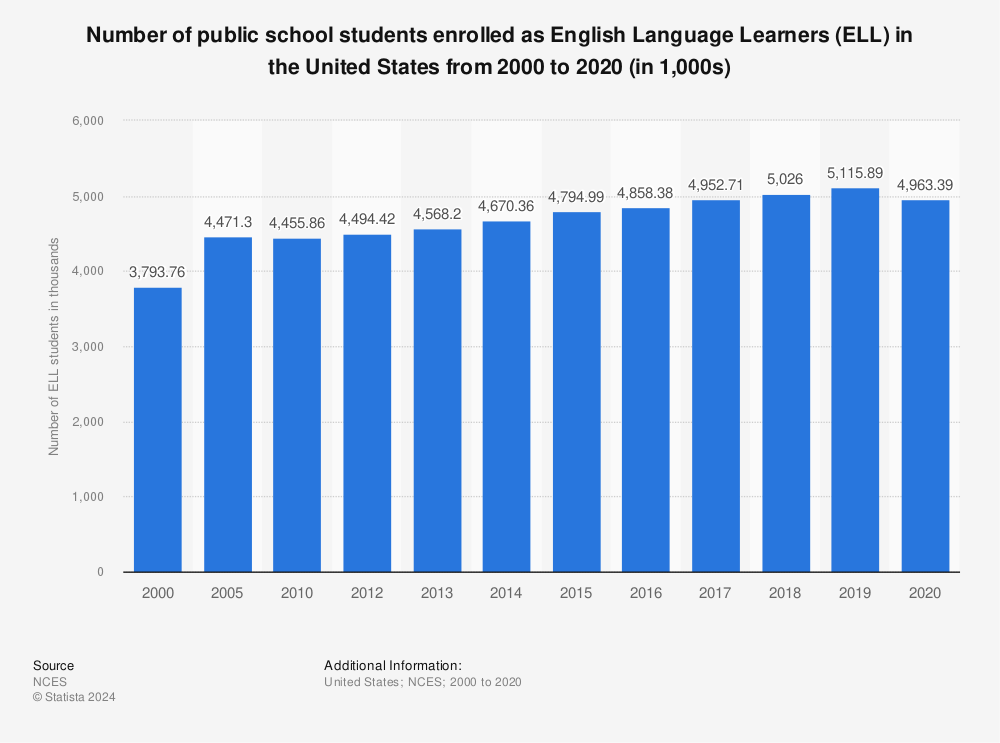What is your favorite tool for teaching in an ELL or Bilingual classroom?
When I taught ESL at the elementary and middle school level, I noticed a pattern forming that took place quite often when new students arrived in my classroom. The pattern was almost a given – and was not something I expected to see during all of my years in education. Many of my students came from different countries and backgrounds, while their levels of education varied across the board. Quite often, they were misdiagnosed with a disability because they would score low on English proficiency tests (which every ELL teacher should expect).

This outcome of putting students into special education classes was solely based on the fact they weren’t yet fluent in English, or may have needed support in building their academic language skills. In many cases, my students needed support from me (the ELL teacher) as well as their subject-content area teachers. This trajectory held many of my students back on their educational path.
ELL Students Across the Country
Let’s first look at the number of ELL students across the country.
In the Fall of 2019, there were approximately 5.12 million English Language Learners (or ELLs) students enrolled in public elementary and secondary schools across the United States. California has the highest number of English Language Learners in the United States. ⅓ of the country’s school districts with the largest ELL populations are in California too.
According to the NEA, researchers estimate that by 2025, 1 out of 4 students in classrooms around the country will be an English language learner student.
The vast majority of the US ELL population speak Spanish. However, we are also seeing growing rates of different languages including Chinese (Cantonese and Mandarin), Russian, Arabic, and Vietnamese.
Right now, there are nearly 5 million ELL students in the US, and providing a well-rounded education (which includes teaching English as well as content area subjects and skills) is one of the biggest challenges we face in public education today.
ELL Reading Challenges
There are many different obstacles teachers face – especially when it comes to teaching reading. For the purpose of this article, we will focus on reading challenges along with solutions.
Just as native speakers do, English language learners (ELLs) face two significant challenges in learning to read English. The first challenge most ELLs face is word recognition, and the second is language comprehension.
However, in addition to typical literacy challenges within those two competencies, ELLs must often work with unfamiliar sounds and letters, as well as unfamiliar vocabulary and language structure.
Some other areas ELL students may struggle with include skipping or replacing words, reading without inflection, ignoring punctuation, and skipping or replacing words such as for, a, an or the. They may also read a word correctly in a familiar passage, but may not be able to use the same word in a different context.
Teachers may have some students in their class who cannot read or write English. Their home language may have a non-Latin alphabet, or they may not be literate in their home language. Also, speaking skills may be at a higher level than their reading and writing ability.
English language learners can face many challenges when reading in English. ELLs may be able to read the words in a book or through a text passage, but it doesn’t mean they will understand the text.

Here are some specific challenges that ELLs face when learning to read in English:
- Some schools may not have enough or the right resources
- Lack of certified ELL or Bilingual teachers
- Some teachers aren’t always aware of “the silent period,” which can hold back a student
- Sometimes students appear to be ready to learn academic language content because they speak well socially, but that doesn’t mean they are ready for high-level academic areas.
- ELLs may not have experience in expressing or understanding the difference between fact and opinion
- ELLs may be anxious to participate and interact with mainstream students due to communication barrier
- ELLs come to class with different cultures, backgrounds, and academic abilities
- Some story themes in the US don’t resonate with students’ background or cultures
- U.S. dialects are different across the country which can cause confusion
- English has many idioms which can make learning confusing
- Homonyms and synonyms can be a challenge
- Word order, sentence structure, and syntax are all unique to the English language
- Some story themes in the US don’t resonate with students’ background or cultures
- Literary terms for story development may be unfamiliar to ELL students – making drawing conclusions, analyzing characters, and predicting outcomes difficult
Interactive Ebooks for ELL Students
Interactive Ebooks came out in the early 2000s. When I was teaching lower level grades, I found Ebooks to be one tool that students gravitated toward—and we found great success in using them.
Interactive Ebooks are a valuable tool for English Language Learning students. They provide several and unique benefits that can enhance their entire language learning experience—from social language to meeting academic language goals.
Here are five ways interactive Ebooks can help ELL students:
Engaging and Interactive Content
Interactive Ebooks offer multimedia elements such as videos, audio recordings, interactive exercises, and animations. Newer Ebooks can even provide instant feedback to students—which encourages them to keep going when they can see a path ahead. AI tools can be embedded in Ebooks, making it quick and easy for teachers to see where students need the most assistance.
These features make the learning process more engaging and captivating for ELL students, and more enjoyable for teachers to use. The interactive nature of e-books encourages active participation and helps maintain students’ interest, which can improve their motivation to learn and practice English.
Enhanced Language Acquisition
Interactive Ebooks also provide opportunities for students to practice and reinforce their language skills in a contextualized manner. Ebooks can offer various interactive exercises and activities which are fun.
Some of these activities include quizzes, interactive games and competitions with friends, and fill-in-the-blanks. All of these activities can help students apply their knowledge of vocabulary, grammar, and reading comprehension. When students are actively engaged in their learning and are having fun, their interest in learning language accelerates language acquisition and retention.
Personalized Learning Experience
Interactive Ebooks often come with customizable features that allow students to adapt the content according to their individual needs and learning pace. Some programs even come with personalized learning plans not only for the individual student, but also for the entire class. When students can work individually on their own growth and within a class – they are getting a more enriched learning experience. Also, by using personalized learning for one student and the entire class, teachers can take some of the weight of their lesson planning off their plates too.
Some programs offer amazing accommodations where students have access to bilingual dictionaries, notepads, highlighters, digital calculators, zoom features, mnemonic devices, spelling assistance, and supplemental aids. This personalization helps students feel more in control of their learning and can enhance their overall learning experience.
Immediate Feedback and Assessment
This instant feedback can help students identify and correct their mistakes in real-time, reinforcing correct language usage and preventing the development of incorrect habits. Additionally, interactive Ebooks may include progress tracking features that allow students and teachers to monitor their performance and identify areas that require further practice and improvement.
Today’s generation is accustomed to quick responses and interaction. Interactive Ebooks can provide immediate feedback on quizzes, tests, exercises and basic activities.
Accessible
One of the significant advantages of interactive Ebooks is their quick accessibility. ELL students can access Ebooks on various devices, such as computers, tablets, or smartphones, allowing them to learn anytime and anywhere with an Internet connection.
This flexibility empowers students to practice English beyond the confines of the classroom, making learning a more integrated and continuous experience.
Interactive Ebooks can provide ELL students with an engaging, interactive, and personalized learning experience that enhances language acquisition, provides immediate feedback, and promotes independent learning. These benefits contribute to a more efficient and enjoyable language learning journey for ESL students.









